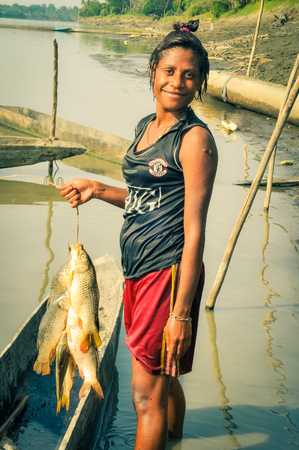Introduction to Freshwater Fish in Indian Culture
Freshwater fish hold a special place in Indian culture, cuisine, and daily life. Across India’s diverse regions, rivers, lakes, and ponds have served as vital sources of nourishment for centuries. In states like West Bengal, Assam, Kerala, and Odisha, fish is not just food but an integral part of local identity and tradition. For example, the Bengali saying “Machhe Bhate Bangali” highlights the cultural bond between rice and fish. Similarly, in Kerala, freshwater fish such as pearl spot and catla are cherished in traditional recipes served at festive occasions and family gatherings.
Beyond cuisine, the significance of freshwater fish extends to rituals and celebrations. Many communities consider certain fish auspicious during religious festivals or marriage ceremonies. Regional variations shape both the type of fish caught and the methods used to keep them fresh after catching. In rural areas, where modern refrigeration is less common, traditional preservation techniques are passed down through generations. These time-tested methods ensure that fish remain fresh and safe to eat despite hot climates and long journeys from river to kitchen.
The importance of preserving the freshness and cleanliness of fish is more than practical—it reflects respect for nature’s bounty and a desire to maintain healthful eating habits. By understanding these traditional Indian ways of handling fish post-catch, we can appreciate the deep-rooted wisdom that continues to shape both local gastronomy and everyday life across India.
2. Choosing the Right Tools and Equipment
In India, the choice of tools and equipment for keeping fish fresh after catching is deeply rooted in tradition. Fisherfolk across the country use locally sourced materials and time-tested methods to ensure that their catch remains clean, fresh, and suitable for consumption. Selecting the right containers not only helps preserve freshness but also respects cultural practices handed down through generations.
Common Traditional Indian Tools
Traditional Indian fishing communities rely on simple yet effective tools immediately after the catch. These tools are designed to minimize handling and reduce spoilage:
| Tool/Equipment | Description | Purpose |
|---|---|---|
| Bamboo Baskets (Tokri/Dala) | Handwoven baskets made from locally available bamboo | Carrying, draining excess water, allowing air circulation to keep fish cool |
| Earthen Pots (Matka/Ghada) | Unglazed clay pots with natural cooling properties | Storing fish in a moist, cool environment to slow spoilage |
| Palm Leaf Mats | Mats woven from palm leaves | Laying out fish for cleaning or sun drying, preventing direct contact with soil |
Benefits of Traditional Containers
Using traditional containers like bamboo baskets and earthen pots offers several advantages over plastic or metal alternatives commonly found today:
- Bamboo baskets are lightweight, eco-friendly, and allow for excellent ventilation, reducing the risk of mold or bacterial growth.
- Earthen pots maintain a naturally lower temperature due to evaporation through porous clay, making them ideal for short-term storage of fish in hot climates.
Cultural Significance
The continued use of these traditional tools is a testament to India’s respect for sustainable practices and resourcefulness. Local names for these items vary by region—such as “tokri” in the North and “dala” in the East—but their purpose remains consistent: preserving the freshness and cleanliness of fish from riverbank to kitchen.

3. Immediate Cleaning Practices at the Riverbank
Step-by-Step Guide to Traditional Indian Fish Cleaning
In many parts of India, especially in rural regions along the Ganges, Brahmaputra, and Godavari rivers, experienced fishers follow a time-tested process to ensure their catch remains fresh and hygienic. Here is a step-by-step guide that reflects local tradition:
Step 1: Selecting a Clean Spot by the Riverbank
After catching the fish, Indian fishers first seek out a shaded, clean area along the riverbank. It is considered important in Indian culture not only for hygiene but also as a mark of respect to the river, regarded as sacred in many communities.
Step 2: Using Fresh Flowing Water for Rinsing
The freshly caught fish are immediately rinsed in the flowing river water. This natural method removes surface slime, mud, and blood. Locals believe that using river water keeps the taste of the fish pure and prevents contamination from stagnant sources.
Step 3: Gutting and Scaling with Local Tools
With a sharp traditional knife (known locally as boti or aruvamanai, depending on the region), fishers deftly remove scales and make a precise cut along the belly. The guts are carefully taken out and disposed of away from the main fishing area to keep the surroundings clean and attract less wildlife.
Step 4: Natural Herbs for Additional Cleansing
A unique aspect of Indian practice is using local herbs such as neem leaves or turmeric roots. These are rubbed onto the fish’s skin and inside the cavity to naturally disinfect and remove any lingering odours. Both neem and turmeric are highly valued in Indian households for their antibacterial properties.
Respecting Local Customs
Many communities also recite short prayers or offer thanks to the river after cleaning, reflecting their gratitude and spiritual connection with nature. Such customs reinforce respect for sustainable fishing practices passed down through generations.
4. Traditional Cooling and Storage Techniques
India’s diverse climates and rural settings have inspired many ingenious, non-refrigerated methods for keeping freshly caught fish cool and fresh until they are ready to be cooked or sold. These traditional techniques make use of locally available resources and time-tested practices that are still relevant in many Indian fishing communities today.
Natural Cooling Methods without Modern Refrigeration
Before the widespread use of refrigerators, Indian fishermen and households relied on natural cooling solutions. The objective was to slow down spoilage by maintaining lower temperatures and preventing exposure to direct sunlight or excessive heat. Here are some classic approaches:
Wrapping Fish in Banana Leaves
Banana leaves are widely available across India and have natural cooling and antimicrobial properties. Freshly cleaned fish are wrapped securely in layers of banana leaves, which help retain moisture and shield the fish from air and contaminants. This method is especially common in southern states like Kerala, Tamil Nadu, and coastal Andhra Pradesh.
Using Cool Mud
Another age-old technique involves covering fish with a layer of clean, cool river mud or clay. The mud acts as an insulator against heat, drawing out excess moisture while keeping the temperature relatively low. After storage, the mud can be rinsed off before further cleaning or cooking.
Submerging in Earthen Pots
Earthen pots (matkas) are known for their natural cooling effect due to their porous nature. Fishermen place cleaned fish inside these pots, sometimes layering them with wet cloths or leaves for added insulation. The pots are then stored in shaded areas or partially buried in cool earth to enhance the effect.
Comparison Table: Traditional Cooling Techniques
| Method | Materials Used | Main Benefits | Popular Regions |
|---|---|---|---|
| Banana Leaf Wrapping | Banana Leaves | Keeps fish moist, adds aroma, eco-friendly | South India, North-East India |
| Cool Mud Covering | Mud/Clay from Riverbanks | Lowers temperature, easy access in rural areas | Punjab, West Bengal, Odisha |
| Earthen Pot Submersion | Clay Pots (Matkas), Water/Leaves | Naturally cools fish, reusable containers | Maharashtra, Gujarat, Rajasthan |
These traditional techniques reflect the wisdom of Indian communities who learnt to preserve fish effectively using whatever nature provided. Even today, such eco-friendly methods are respected for their simplicity and sustainability, especially where electricity or refrigeration remains scarce.
5. Use of Indigenous Herbs and Natural Preservatives
Harnessing the Power of Traditional Indian Ingredients
In the heart of Indian coastal villages and river communities, the wisdom of using indigenous herbs and natural preservatives to keep fish fresh has been passed down through generations. Rather than relying solely on modern refrigeration, many Indian families trust in time-tested local ingredients to clean, rub, and preserve their catch safely. This practice not only maintains the freshness but also infuses subtle flavours that are cherished in regional cuisines.
Turmeric: Nature’s Antibacterial Agent
Turmeric, or haldi, is a staple in every Indian kitchen, celebrated for its potent antibacterial and antifungal properties. After cleaning the freshly caught fish with water, villagers often rub turmeric powder generously over the surface and inside the cavity of the fish. This golden spice helps prevent bacterial growth, reduces odours, and imparts a mild earthy aroma to the flesh. The fish may be left coated with turmeric until ready to cook or store further.
Neem Leaves: A Natural Cleanser and Preservative
The neem tree (Azadirachta indica) is revered across India for its medicinal benefits. Fresh neem leaves are sometimes used in rural areas to rinse or wrap fish after cleaning. The leaves’ natural antimicrobial qualities help deter spoilage and ward off insects during transport. In some regions, fishmongers will layer neem leaves between stacks of cleaned fish, especially when selling at open-air markets.
Tamarind: Cleansing and Tenderising
Tamarind pulp or leaves are another popular choice for cleansing fish. The slightly acidic nature of tamarind aids in removing residual slime and any lingering muddy smell from freshwater catches. Rubbing tamarind over the fish’s skin before rinsing can leave it cleaner and subtly tenderised, preparing it perfectly for marination or cooking according to local recipes.
A Blend of Tradition and Sustainability
By utilising these indigenous spices and plant materials—turmeric, neem, tamarind, and others like coriander or curry leaves—Indian communities have developed eco-friendly ways to keep their fish safe without artificial chemicals. These methods not only respect ancestral knowledge but also align with sustainable living practices deeply rooted in Indian culture.
6. Transporting Fish to Market or Home
Maintaining the freshness and cleanliness of fish during transit is a vital step in the traditional Indian fishing process. Indian fishers have developed unique and practical methods rooted in local wisdom, ensuring that the catch arrives at the market or home in prime condition. One of the most common practices is the use of insulated baskets, known locally as “tokri” or “kavadi”, often crafted from bamboo or cane. These baskets are not only sturdy but also allow for air circulation, preventing heat build-up that can spoil the fish.
Insulated Baskets and Natural Cooling
To enhance insulation, fishers frequently line these baskets with banana leaves, coconut fronds, or even wet jute sacks. This layering technique helps maintain moisture and lowers internal temperature, creating a natural cooling effect. The use of such plant materials is both sustainable and effective, reflecting a deep respect for the environment and traditional ecological knowledge.
Layering Techniques with Local Materials
The layering process is done with great care: freshly caught fish are placed gently on top of a layer of moist leaves, then covered again with another set of leaves before closing the basket. This prevents direct contact between fish and dust or contaminants during transport over bumpy rural roads or crowded markets. In coastal regions like Kerala and West Bengal, betel leaves and palm mats are particularly popular due to their antimicrobial properties, helping keep the fish clean and odour-free.
Community Practices Ensuring Freshness
Community cooperation is another hallmark of Indian tradition. In many fishing villages, groups of families work together to sort, pack, and transport fish efficiently. Elderly members oversee packing procedures while younger ones help carry baskets to boats, carts, or even bicycles for quick delivery. This collective approach ensures accountability and adherence to hygiene standards passed down through generations. By combining insulated containers, local materials, and strong community bonds, Indian fishers successfully deliver fresh and clean fish from riverbanks and coasts right to urban kitchens and village markets.
7. Cultural Beliefs and Community Wisdom
In India, the act of catching and handling fish is deeply intertwined with cultural beliefs, proverbs, and inherited community wisdom. These traditional values not only guide practical techniques but also emphasize a harmonious relationship with nature. Popular sayings such as “Jal hi jeevan hai” (Water is life) highlight the importance of respecting water bodies, which are considered sacred in many regions. Fisherfolk often observe specific taboos, such as avoiding fishing during certain festivals or auspicious days, believing that these periods allow aquatic life to rejuvenate. Another common folk practice is to release the first catch back into the water as an offering to river deities, ensuring good fortune and abundance for future hauls.
Community elders frequently remind younger generations about sustainable fishing practices through proverbs like “Zyada pakdo toh kal kuch nahi milega” (If you catch too much today, there will be nothing left for tomorrow). This wisdom discourages overfishing and encourages selective harvesting of mature fish only. Additionally, some communities believe that using natural materials for storage and cleaning—such as banana leaves or clay pots—not only preserves freshness but also honours age-old traditions. Respecting these customs ensures that fish remains fresh after catching while reinforcing collective responsibility towards water conservation.
By adhering to such beliefs and folk wisdom, Indian fishing communities maintain a delicate balance between livelihood and environmental stewardship. These cultural practices serve as informal guidelines that foster respect for nature, promote sustainable resource management, and strengthen social cohesion within the community. Ultimately, the integration of cultural values into everyday fishing routines highlights the enduring role of tradition in keeping fish fresh and clean in India’s diverse regions.


